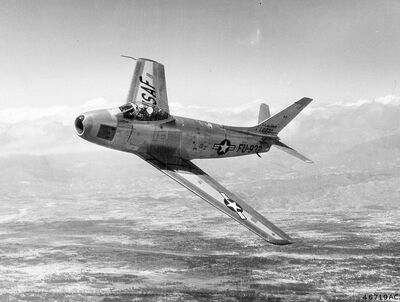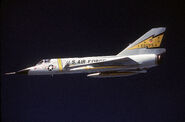(Editing a gallery) Tag: gallery |
(Editing a gallery) Tag: gallery |
||
| Line 16: | Line 16: | ||
3_69_a2.jpg |
3_69_a2.jpg |
||
5526117086_416e2cb345_b (1).jpg|RAAF variant of the F-86 |
5526117086_416e2cb345_b (1).jpg|RAAF variant of the F-86 |
||
| + | image.jpeg |
||
</gallery> |
</gallery> |
||
Revision as of 06:26, 2 July 2016
The North American F-86 Sabre was a single engine fighter aircraft of the Cold War. It was designed and manufactured by North American Aviation.

Development and History
In the year 1944 two prototypes of the NA-134 were contracted, which can be called the precursor of the NA-140. On 18th May 1945 the USAAF ordered three NA-140, called XP-86. In August 1945, after analysing German design and development documents, the USAF decided to equip the F-86 with swept wings, which were based on the wings of the Me 262, a German jet-powered World War II fighter. The prototype was first flown on 1st October 1947. On 25th April 1948 it had it´s first supersonic flight in a nosedive. In the same year the P-86 was renamed to F-86. The F-86 entered service in 1949. A variant for the US Navy was developed and called FJ-1 Fury, initially with unswept wings.
The North American F-86 was the only American Fighter with the ability to defeat a Mikoyan-Gurevich MiG-15 in aerial combat. The F-86 had inferior performance but it was able to outmanoeuvre the MiG-15 in dogfight. In the Korea War the F-86 was used as an air superiority fighter, to prevent the MiGs attacking Allied ground troops. The tactic was successful, so the UN was allowed to use their aged aircraft like the F-80, the F-84 and the Gloster Meteor as fighter-bombers. On the other side the North Korean and Chinese ground troops didn’t receive close air support. On 17th December 1950, the first MiG-15 was downed by a F-86, which was flown by the American pilot Bruce H. Hinton. The most successful pilots were James Jabara with 15 downed MiG-15 and George A. Davis Jr. with eleven downed MiGs in the year 1951.
After the Korea War the F-86 became the flag-ship plane of the NATO. Even though the F-86 was designed to be a dayfighter, North American developed a radar equipped all-weather F-86 derivative, the F-86D.
The US Air Force was able to reach the new speed world records with the F-86, the first was on 15th September 1948 (F-86A, 1079.841 km/h), the second on 19th November 1952 (F-86D, 1124.137 km/h) and the last one on 16th July 1953 (F-86D, 1151,883 km/h).
The Commonwealth Aircraft Corporation in Australia designed and built a modified version of the F variant, which used a Rolls Royce Avon engine in place of the GE J-47, and two 30mm ADEN cannon instead of the six 0.5in machine guns originally fitted.[1]
Gallery
Referernces
- ↑ Green, William and Gordon Swanborough. The Complete Book of Fighters. Salamander Books. 2001. ISBN 0 84065 269 1 Pages 115-116


